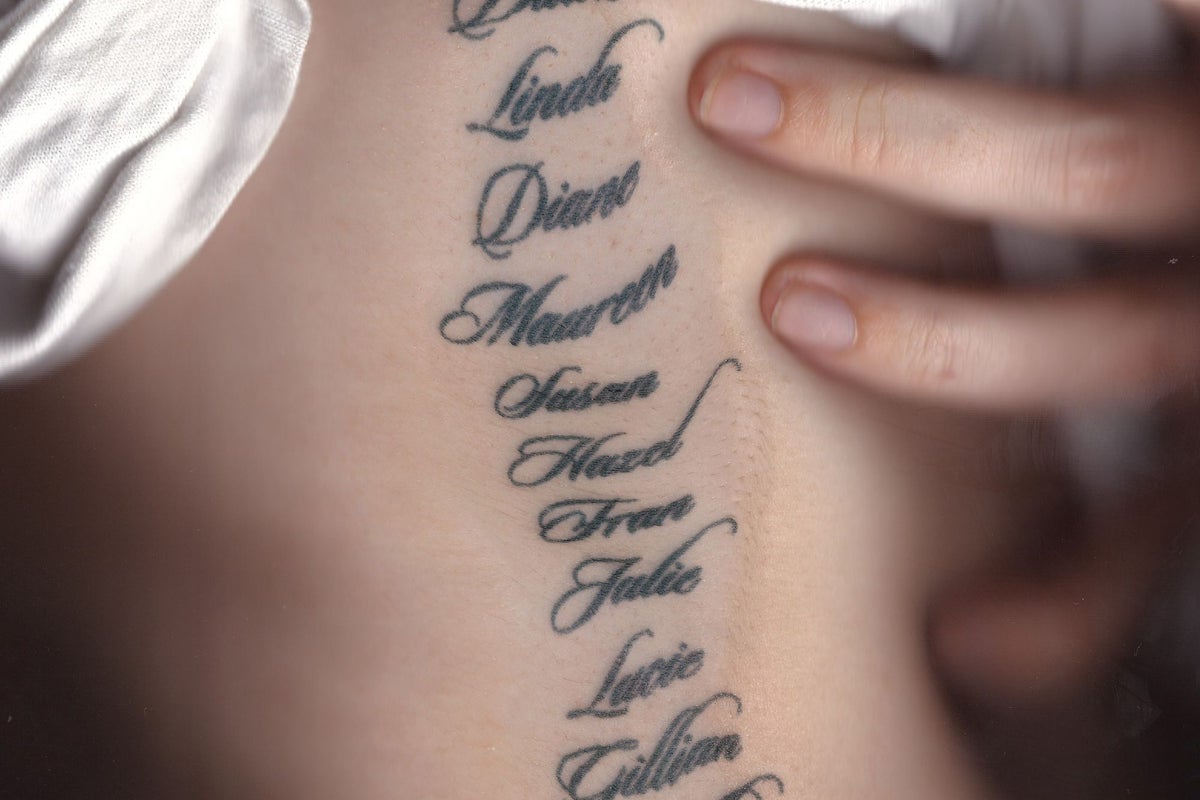Tattooing Your Ex-Lovers’ Mothers’ Names: The Radical Act of Reclaiming Relationships in a Time of Cultural Reckoning
In the realm of contemporary art, personal expression often crosses the boundaries of societal norms. A striking example is found in Harriet Richardson’s audacious choice to tattoo the names of her ex-lovers’ mothers across her torso. This body art not only pays homage to the influential relationships that have shaped her life but serves as a provocative commentary on the intersection of love, familial ties, and the complexities of romantic entanglements. The act itself recalls Tracey Emin’s landmark installation, “Everyone I Have Ever Slept With 1963–1995,” which laid bare the artist’s sexual history, sparking conversations about intimacy, vulnerability, and the public display of personal narratives.
Richardson’s tattoos evoke a visceral reaction, challenging viewers to confront their own relationships and the roles that familial connections play in romantic dynamics. In a world increasingly defined by social media facades and superficial connections, the act of inscribing the names of mothers onto one’s skin becomes a powerful statement about the importance of recognizing and valuing the roots of our partners, as well as the complexities of human connection.
The decision to tattoo the names of past lovers’ mothers raises questions about the nature of attachment and the influence of parental figures in shaping our romantic choices. The mother-son or mother-daughter bond is often one of the most significant relationships in a person’s life; it can dictate how individuals approach intimacy, communication, and conflict resolution within their romantic encounters. By acknowledging the mothers behind her ex-lovers, Richardson not only honors them but also engages in a form of emotional exploration that could lead to healthier relationships in the future.
Critics may argue that such an act is merely an attention-seeking stunt, an attempt to provoke outrage or astonishment in an already saturated art world. However, the deeper implications of Richardson’s work deserve a more nuanced examination. The tattoos serve as a physical manifestation of one’s past, a permanent reminder of the connections that have been made and lost. In doing so, they present an opportunity for catharsis, allowing for the release of unresolved feelings and the potential for personal growth.
As societal norms around relationships continue to evolve, Richardson’s decision can be viewed as both radical and refreshing. In a culture that often emphasizes the transient nature of modern love, this tattooing serves as a reminder of the historical and emotional depth of our connections. By embracing vulnerability through body art, Richardson opens the door to conversations about how we can learn from our past relationships, not just in terms of romantic partners but also regarding the influential figures who raised them.
Furthermore, the reaction to her tattoos has been varied. Some individuals view it as a bold declaration of self-identity, a way of reclaiming her narrative from the shadows of past lovers. Others see it as an act of defiance against societal expectations of how we should express our romantic histories. In either case, Richardson’s artwork pushes the boundaries of conventional expression, encouraging people to reflect on their own experiences with love and loss.
The implications of such body modifications extend beyond the personal; they touch on broader cultural themes of how we view relationships in the digital age. Many people today grapple with the challenge of forming deep, meaningful connections amid a barrage of fleeting interactions facilitated by technology. This societal backdrop adds another layer of complexity to Richardson’s work, prompting a discussion about the genuine connections that can sometimes be obscured by the noise of modern life.
Moreover, the presence of the mothers’ names on her body can provoke dialogue about the role of familial influence in contemporary relationships. How do parental figures shape our expectations of partners? To what extent do they influence our emotional well-being and approach to intimacy? By inscribing these names, Richardson underscores the inextricable link between familial relationships and romantic endeavors, suggesting that understanding our partners’ backgrounds can lead to deeper, more empathetic relationships.
This artwork also serves as a commentary on the notion of ownership in relationships. Traditionally, romantic partners may feel a sense of entitlement over one another’s emotional landscape. By tattooing the names of her lovers’ mothers, Richardson flips this notion on its head, suggesting an alternative view of relationships that emphasizes recognition and appreciation of the past rather than possessiveness. This act of honoring the maternal figures in her ex-lovers’ lives challenges conventional narratives about love and attachment, inviting viewers to reconsider their own perceptions of ownership in romantic settings.
As the conversation around mental health and emotional well-being continues to gain traction, Richardson’s tattoos can also be viewed within the framework of self-care and healing. Recognizing the impact of past relationships on our mental state is crucial for personal growth. By memorializing her ex-lovers’ mothers, Richardson engages in a process of acknowledgment that could lead to healing from past wounds. In doing so, she may inspire others to reflect on their own histories and the influence of their partners’ familial ties on their emotional health.
The public response to Richardson’s work has been mixed, ranging from admiration for its boldness to bewilderment at the act’s perceived absurdity. This division is emblematic of broader societal tensions concerning how we navigate love in an era defined by rapid changes in relationship dynamics. While some view the tattoos as an innovative form of self-expression, others question the practicality and permanence of such decisions. The polarization of opinions serves as a reflection of the cultural discourse surrounding relationships, intimacy, and the myriad ways individuals choose to express their identities.
As this dialogue evolves, it is essential to recognize that art, especially body art, often serves as a mirror reflecting the complexities of human experience. Richardson’s tattoos ultimately invite a reckoning with the past, urging both artist and viewer to confront the intricacies of love, loss, and the indelible marks they leave behind. The act of tattooing the names of her lovers’ mothers may seem eccentric, but it serves a greater purpose: to highlight the importance of understanding the roots of our connections as we navigate the often turbulent waters of romantic relationships in today’s world.
The conversation sparked by Richardson’s choice transcends the personal; it delves into the cultural fabric of how we understand romantic love, familial influence, and self-identity. In a society where authenticity is often sacrificed for superficiality, her work stands as a testament to the power of vulnerability, challenging us to embrace the complexities of our experiences as we seek connection in an ever-changing landscape.
Reminiscent of Tracey Emin’s artwork titled Everyone I Have Ever Slept With 1963–1995, artist Harriet Richardson has taken it one step further and inked the names of her lovers’ mothers on her body. Here she tells Maja Anushka what the reaction has been and why it might make for better relationships in the future.

